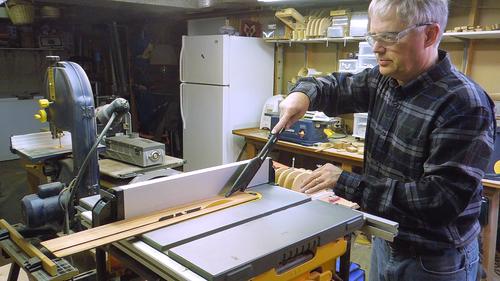 For this tenor ukulele, Pat is using some koa wood from Hawaii.
He starts by ripping the sides to the correct width on his table saw.
For this tenor ukulele, Pat is using some koa wood from Hawaii.
He starts by ripping the sides to the correct width on his table saw.
 For this tenor ukulele, Pat is using some koa wood from Hawaii.
He starts by ripping the sides to the correct width on his table saw.
For this tenor ukulele, Pat is using some koa wood from Hawaii.
He starts by ripping the sides to the correct width on his table saw.
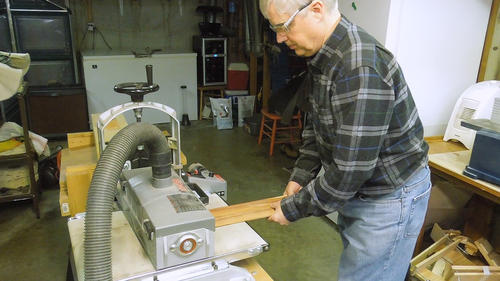 The wood, as bought, was already in strips about 4 mm thick, so Pat is using
his thickness sander to bring it down to 2 mm. s
The wood, as bought, was already in strips about 4 mm thick, so Pat is using
his thickness sander to bring it down to 2 mm. s
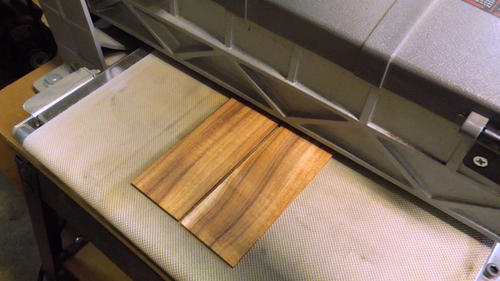 Note that this is not the thickness sander that he built,
he got this one for relatively cheap, and the power feed
is a nice thing to have. He still uses his homemade one for some tasks though.
Note that this is not the thickness sander that he built,
he got this one for relatively cheap, and the power feed
is a nice thing to have. He still uses his homemade one for some tasks though.
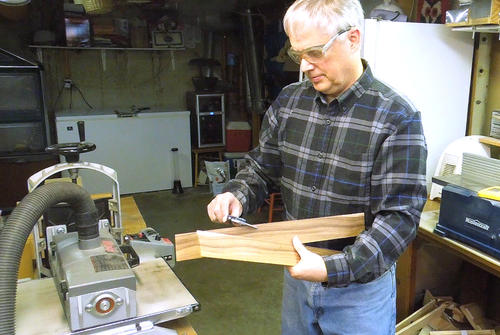 Checking the thickness of the material. Getting close to desired thickness.
Checking the thickness of the material. Getting close to desired thickness.
Thickness sanders, especially ones open on one side, are not entirely rigid, so it's best to approach the correct thickness gradually.
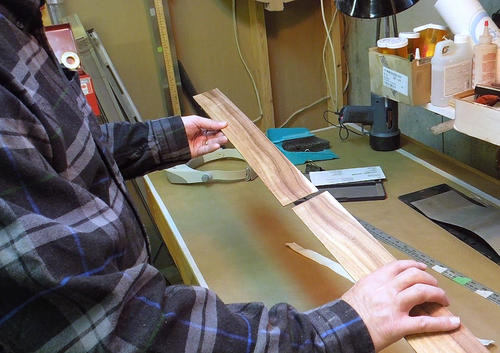 Symmetry is good, here Pat is deciding which way to orient the pieces. The part with
the sap wood will go near the tail. You have to be careful to get the orientation
right when you bend it.
Symmetry is good, here Pat is deciding which way to orient the pieces. The part with
the sap wood will go near the tail. You have to be careful to get the orientation
right when you bend it.
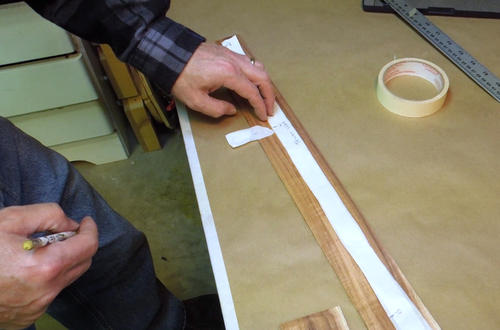 Pat applies a piece of tape where the waist of the ukulele will be. This will help
guide where to place the strip on the bending form.
Pat applies a piece of tape where the waist of the ukulele will be. This will help
guide where to place the strip on the bending form.
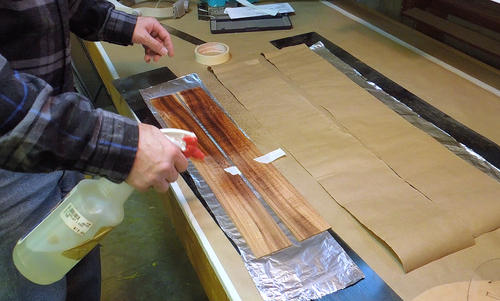 Next, Pat sprays the strips with a "veneer softener" on both sides.
Veneer softener is a soapy water solution that penetrates the wood more easily.
Next, Pat sprays the strips with a "veneer softener" on both sides.
Veneer softener is a soapy water solution that penetrates the wood more easily.
The wet surface really brings out the colour of the wood!
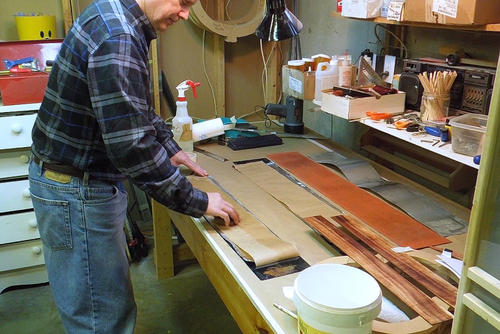 The wood is sandwiched between two wet layers of packing paper. Here he's wetting
the paper with a sponge.
The wood is sandwiched between two wet layers of packing paper. Here he's wetting
the paper with a sponge.
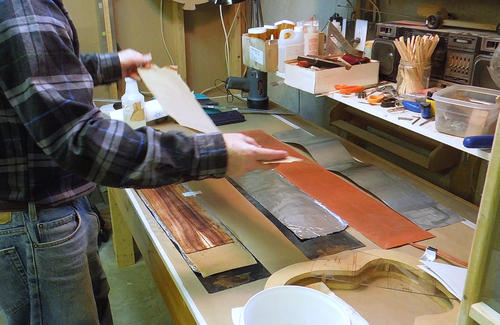 Building up the sandwich. The sandwich consists of the wood in the middle, wet packing paper
on either side, then a layer of tinfoil, and then some spring steel. The tinfoil is there to
keep rust from the spring steel from staining the wood through the paper. The spring
steel is for support to keep the wood from kinking too much.
Building up the sandwich. The sandwich consists of the wood in the middle, wet packing paper
on either side, then a layer of tinfoil, and then some spring steel. The tinfoil is there to
keep rust from the spring steel from staining the wood through the paper. The spring
steel is for support to keep the wood from kinking too much.
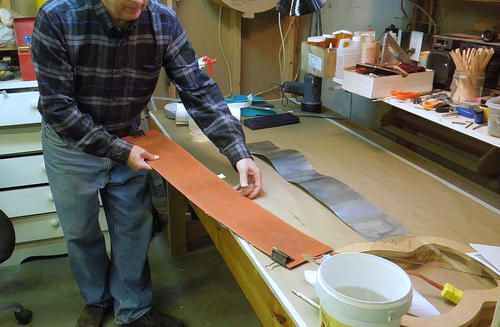 A rubber heating blanket goes on top of the sandwich, and a layer of aluminium flashing
goes on top of that to avoid damaging the heating blanket.
A rubber heating blanket goes on top of the sandwich, and a layer of aluminium flashing
goes on top of that to avoid damaging the heating blanket.
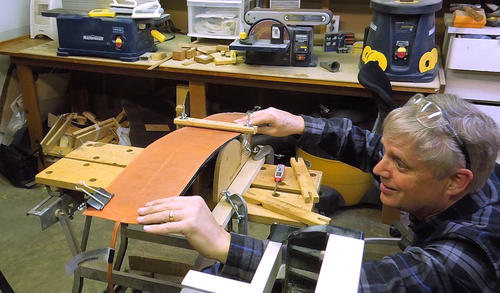 Here's mounting the sandwich on the bending jig. Pat initially forgot the aluminium flashing,
but he slipped it in afterwards.
Here's mounting the sandwich on the bending jig. Pat initially forgot the aluminium flashing,
but he slipped it in afterwards.
Next, the heating blanket is powered up, letting the sandwich heat up to about 300° F (130° C).
 Once the sandwich is hot, it's pulled in at the waist area, then bent around the neck and tail
of the form.
Once the sandwich is hot, it's pulled in at the waist area, then bent around the neck and tail
of the form.
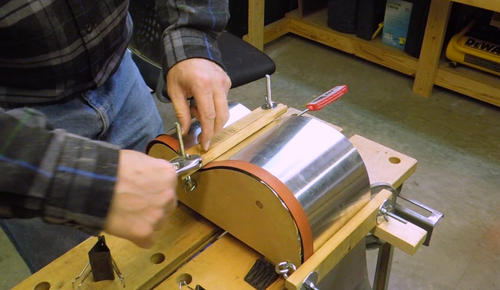 Pat monitors the temperature with a small electronic thermometer.
Here he's further tightening the bending form at the waist.
Pat monitors the temperature with a small electronic thermometer.
Here he's further tightening the bending form at the waist.
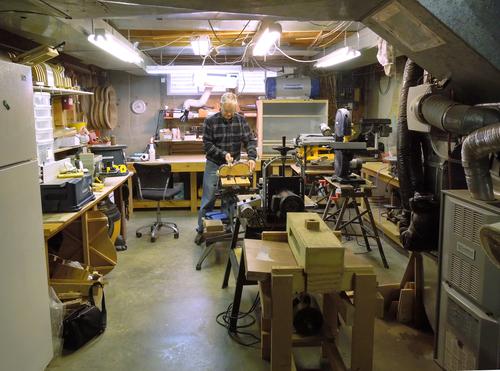 After initial bend, Pat lets the form cool down, then brings the temperature back up to
300° F (130° C) before letting it cool down again.
The second heating and cooling cycle helps the wood retain the shape better.
After initial bend, Pat lets the form cool down, then brings the temperature back up to
300° F (130° C) before letting it cool down again.
The second heating and cooling cycle helps the wood retain the shape better.
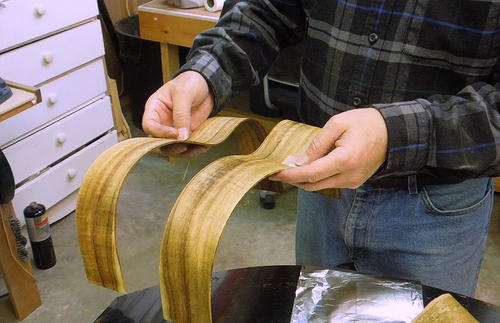 Once taken out of the bending form, the pieces retain their shape nearly perfectly.
Once taken out of the bending form, the pieces retain their shape nearly perfectly.
This is a better method than my steam-bending and over-bending. Being able to heat the wood to beyond the boiling point of water, and being able to keep it hot for an extended period really helps. But it does require having a fancy heating blanket.
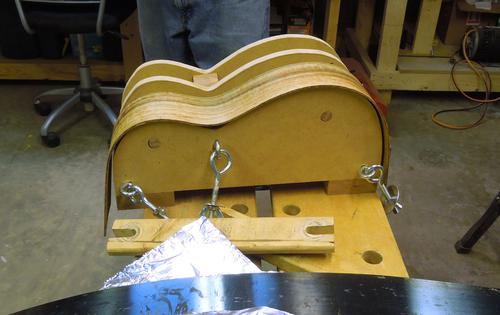 I took some measurements with my radius gauge, and I'd say the spring-back with
this method is maybe 5%, whereas it was about 20% with my method.
I took some measurements with my radius gauge, and I'd say the spring-back with
this method is maybe 5%, whereas it was about 20% with my method.
See also: Me bending the sides
Next: Pat making the sound board
To my ukulele page
![]()